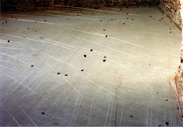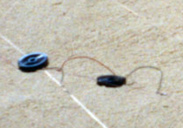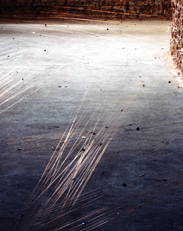|
Kupferdraht mit Lautsprechern singuhr-hœrgalerie, Parochialkirche Berlin 1996, von 0 - 24 Uhr Galerie Forum Kunst, (a documentation of the work), Weilheim Teck, 1998 |
Thin copper wire, 300 small piezo-speakers, 300 relays, computer |
|
|
Photo: Thomas Bruns |
»One of the first common works, together with Klaus Lebkücher, was the Kupferdraht mit Lautsprechern (Copper Wire with Loudspeakers) installation at the Singuhr sound gallery in the Parochial Church in 1996 in Berlin. In retrospect, this piece holds a type of key function for both artists. It was here that the main characteristics of their artistic projects crystallized. In a way, Kupferdraht mit Lautsprechern pictographically mirrors their subtly reserved, yet systematically permeating working styles. Step by step, a dense network of fine copper wiring was spanned across the belfry of the Parochial Church. Anchors were placed where their paths crossed—300 small piezo loudspeakers in total. “Coincidental” intersections and relationships result in the prevailing compositional “system” that does not operate hierarchically but, like the old bricks of the belfry’s vaults, is built according to a distribution of forces that is stable but versatile and outwardly autonomous. The listener and observer is met with a visually and acoustically homogenous image, as spatial and temporal structures follow an inner logic that corresponds to the architectonic fabric. Computer-controlled electrical impulses distributed via 300 relays create a loudspeaker-specific clicking sound based on variable rhythms and motion sequences. If two “clicks” meet at a junction or loudspeaker, the respective motion patterns become modified, and their speed sometimes changes. In this way, new musical movements and patterns can constantly be heard in the space over the entire installation period. With a bit of caution, the visitor can step inside the partially physically accessible net and, in doing so, into the acoustic events. The distance or closeness of the happenings in the space elucidate the rooms for manoeuvre opposite the surrounding, static architecture and therefore energetically transformed “tensions” of the vault’s imprint.« (positionen, 70, Beiträge zur Neuen Musik, Februar 2007, Melanie Uerlings) |
| von den Driesch & Dyffort | klanginstallationen | video | aktuell |
©dyffort & driesch






